Secrets For Making The Perfect Spaghetti Sauce You'll Wish You Knew Sooner
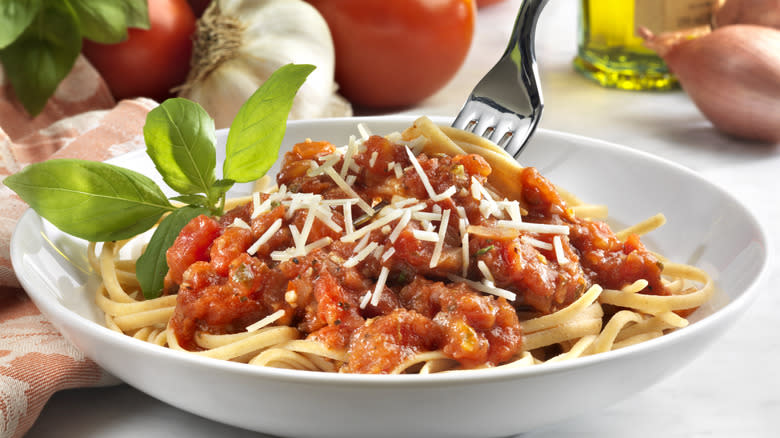
We may receive a commission on purchases made from links.
Store-bought spaghetti sauce might seem like the easiest way to get dinner on the table, but homemade spaghetti sauce is surprisingly easy to prepare. And that makes sense — according to Chef Claudio Daggio at Terralina Crafted Italian in Disney Springs, "Traditional Italian food is simple and all about the quality of the ingredients where less is more." Just a handful of ingredients and less than an hour of time in the kitchen, and you'll be digging into some of the best spaghetti sauce you've ever tried.
That said, there's no one-size-fits-all approach when it comes to the perfect spaghetti sauce. Some people like their sauce a touch on the sweeter side to evoke the nostalgic store-bought sauces of yore. Others like to zhuzh things up with herbs, spices, or even chiles for a touch of heat. "It's good to play around with different herbs, seasonings, and techniques to craft the perfect balance for your palate," says Daggio.
If you're looking for a place to start — and a few tricks of the trade to make your sauce truly shine — look no further. Our experts are here to help you craft the perfect spaghetti sauce right at home.
Read more: Ingredients To Take Your Scrambled Eggs To The Next Level
Don't Confuse Your Nomenclature
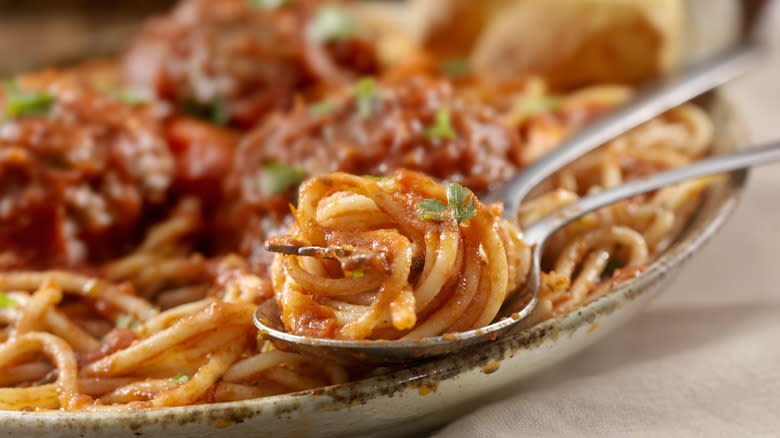
Before you start cooking your perfect homemade spaghetti sauce, first bear in mind that not all tomato-based sauces are created alike. For Claudio Daggio, the simplest tomato-based pasta sauce is marinara, a sauce he categorizes as "relatively plain." Its goal, he says, is to showcase the taste of the tomatoes "without a lot of other supporting characters muddling the flavor." Indeed, chef and author Lidia Bastianich tells the New York Times that marinara is all about "feeling the tomatoes in your mouth."
Tomato sauce, on the contrary, may have a bit more oomph to it. "Tomato sauce is a broader category of smooth, long-cooked, and potentially more complex tomato-based sauces," says Daggio; the New York Times places tomato sauces like long-cooked sugo al pomodoro or meaty ragus in this category. As for spaghetti sauce, this is a bit of a catchall term for both marinara and tomato sauce, not to mention any other sauce you might imagine serving with spaghetti. These sauces, according to Daggio, may or may not include added ingredients like veggies, protein, or even cream.
However, not all experts agree on this categorization. For Chef and Owner Amy Brandwein of Centrolina and Piccolina da Centrolina in Washington, D.C., all of these phrases are simply "the American way of describing salsa pomodoro — a sauce made out of onion, tomato, basil and olive oil."
Start With Great Tomatoes
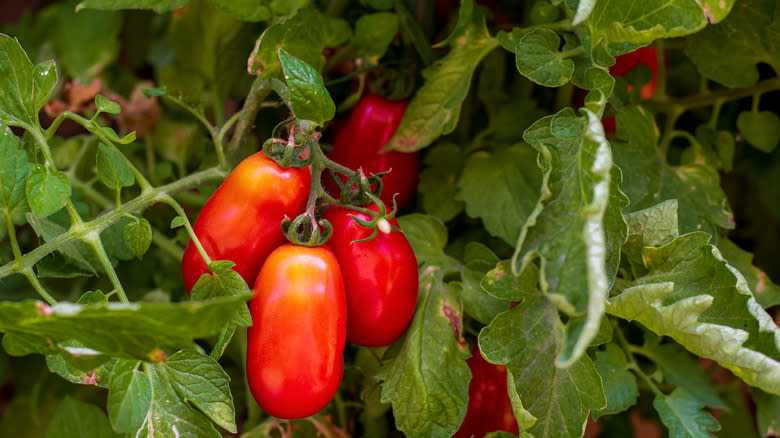
Once you've got your vocab squared away, you can start shopping for your main ingredient: tomatoes. And bear in mind that not any tomato will do. Because these are the core of your sauce, you'll want to aim for the best quality possible, according to Claudio Daggio, who says that using great quality tomatoes is "crucial" for a great spaghetti sauce.
When using canned tomatoes to make spaghetti sauce, most recipes call for San Marzanos, which hail from the volcanic soil near Mount Vesuvius, and Daggio and Amy Brandwein are no exception. Their low seed content, balanced flavor, and low acidity makes these Southern Italian tomatoes perfect for tomato sauce. Once summer arrives, both Daggio and Brandwein love using fresh tomatoes to make spaghetti sauce. Brandwein loves beefsteak or red ripe tomatoes, noting that heirloom tomatoes — including her favorite yellow tomatoes — also "make an amazing sauce." Daggio agrees, citing other heirloom varieties like Brandywine, Cherokee Purple, or Mortgage Lifter, which he says, "have incredible old-fashioned tomato flavors that make for aromatic, deeply flavored sauces."
Season Your Spaghetti Sauce With Fresh Herbs
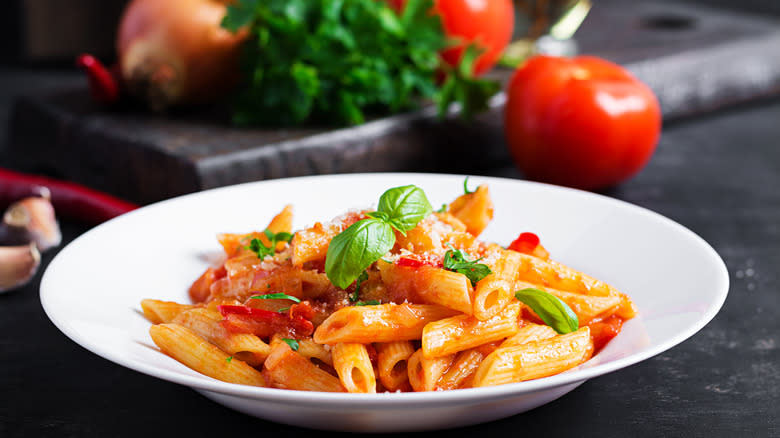
When you start with great tomatoes, you don't need to do much to make them shine. However, their innate deliciousness doesn't stop our chefs from adding a bit of flair in the form of herbs — which, at least according to Amy Brandwein, should never be dried. "Always fresh," she counsels, noting that when she is using fresh tomatoes, nothing could be simpler than to pull together a spaghetti sauce in minutes. "I grate the tomato and add it to the pan with a little garlic, basil and simmer," she says. "Add a touch of butter/extra virgin and you have a sauce that is made in heaven. You can't put a price on it!"
Claudio Daggio too loves using fresh herbs, particularly at the end of cooking. "I finish it off with a generous amount of chopped fresh basil and parsley," he says of his spaghetti sauce. Adding the herbs — particularly delicate basil — right at the end keeps them from losing their fresh flavor, as they can if simmered too long. A few minutes in the hot sauce is all they need to suffuse it with delicious aroma.
Season Your Spaghetti Sauce With Dried Herbs
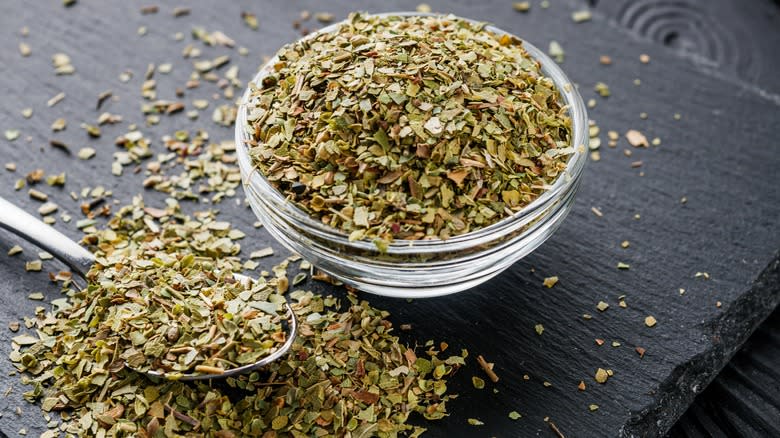
Amy Brandwein chooses to season her spaghetti sauce exclusively with fresh herbs, and this in spite of their presence in many Italian-American iterations of marinara sauce, which she says tend to feature pungent, powerful oregano. But Claudio Daggio likes to take advantage of both fresh and dried herbs in his spaghetti sauce, which he says gives the final product "the best flavor impact."
Dried herbs and fresh herbs don't act the same way when cooked, and as such, they shouldn't be added to spaghetti sauce at the same time. Daggio begins his sauce by seasoning it with a combination of dried Italian herbs like oregano, basil, or thyme. Other herbs that might be welcome in spaghetti sauce include marjoram or chile flakes for a touch of heat. Once the base has infused with these herbs, adding fresh basil and parsley towards the end, he says, "gives you those wonderful layers of herbal flavors."
Take The Time To Build Layers Of Flavor
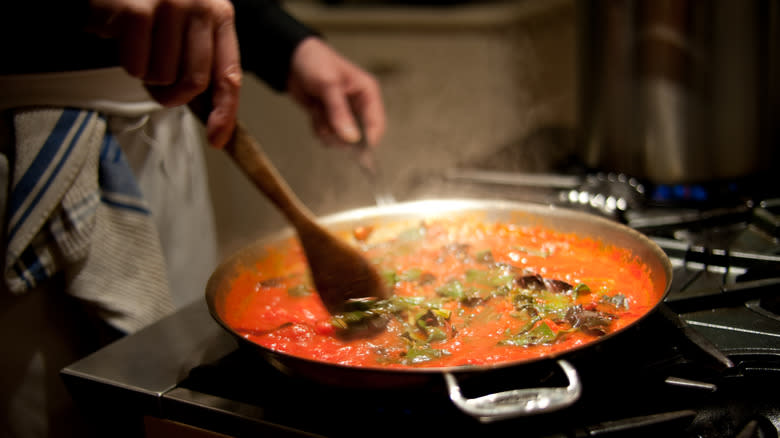
Spaghetti sauce doesn't require a ton of hands-on time to make, but you do need to give it some time to simmer — especially, according to Amy Brandwein, if you are using canned tomatoes. "Depending on the amount of sauce you have, it needs to simmer for 45 minutes — over an hour and sometimes up to two," she says, with the caveat that, of course, at her restaurant, "we cook a larger volume than most!"
Claudio Daggio agrees that time is an essential component of the perfect spaghetti sauce, noting that a good one "benefits greatly from a long, gentle simmer." But don't let the long simmering time put you off if you're trying to pull together a quick and easy dinner. Daggio notes that while a long simmer will indeed pave the way for "much richer, deeper flavors," a shorter cooking time is a-OK. "You can certainly make a perfectly acceptable sauce by simmering for 30 minutes or so," he says.
Don't Be Afraid Of Sugar
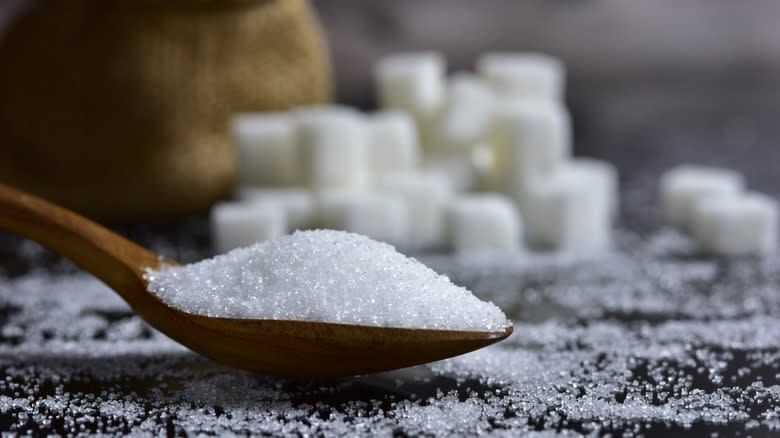
You might not think it, but many store-bought spaghetti sauces contain quite a bit of sugar — and that makes sense. Sugar, according to Claudio Daggio, "helps to balance the acidity and enhances the natural sweetness of the tomatoes."
While Amy Brandwein eschews the use of sugar in spaghetti sauce, Daggio notes that he sometimes adds "a small amount of sugar" to his sauces. How much depends entirely on the quality of the tomatoes. While good-quality San Marzano tomatoes naturally have low acidity, tomatoes with higher acidity may be balanced quite nicely by sugar, whether a pinch or a spoonful. As for how much to add, this is largely a matter of preference. Start with just a bit and taste as you go until you reach the right balance of acidity and sweetness.
If you don't love the idea of adding sugar to your spaghetti sauce, you can rely on other staples for a similar effect. Onions and carrots are both naturally sweet, and if you chop them finely enough, they'll not only brighten the sauce, they'll also disappear into it so that picky kids will be none the wiser!
Consider Adding Some Umami
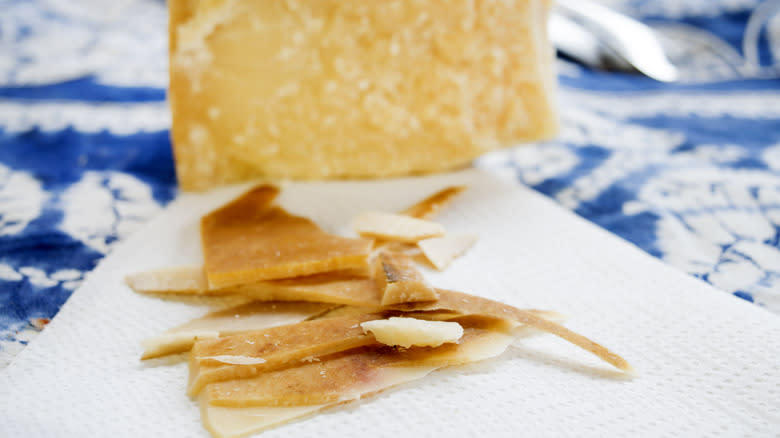
Tomatoes are naturally rich in glutamic acid, an amino acid that contributes to increased umami, that fifth taste perhaps best translated as savoriness or meatiness. But you can push the moreish quality of your spaghetti sauce over the edge by reinforcing this natural richness with other sources of umami, such as Parmesan rinds. "I do many times use Parmesan rinds in my sauce to add that aged nutty flavor," says Claudio Daggio.
This trick isn't just great for the flavor of your sauce; it also cuts down on food waste. As you use Parmesan cheese at home, be sure to carefully save any rinds in a sealed plastic bag in the freezer. That way, anytime you need to add oomph to your spaghetti sauce, an extra source of glutamate is never far away.
And Parmesan is not the only way you can up the umami quotient of your spaghetti sauce. Soy sauce and miso paste are both rich in glutamate — and adding either one will add even more savoriness to the finished sauce.
Don't Be Afraid Of Fat
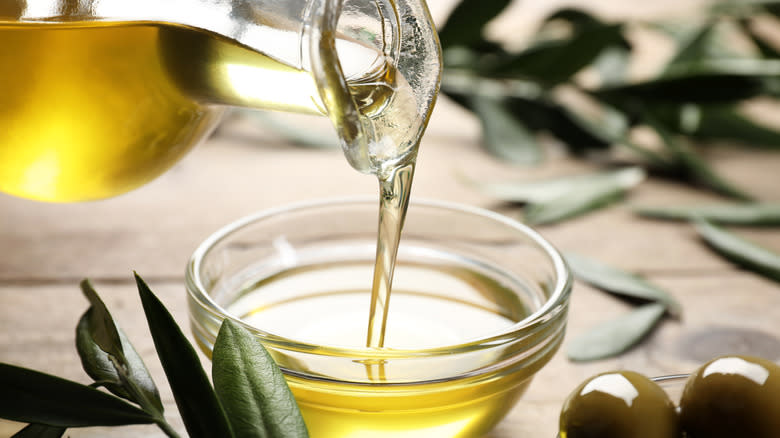
In addition to great tomatoes and careful seasoning, a great spaghetti sauce needs a touch of fat, which helps to enhance the other flavors in the sauce and give it a more luxurious, silky mouthfeel. But which fat to use? For Amy Brandwein, the answer is simple: "Olive oil, extra virgin." But Claudio Daggio adds a bit more flair.
"I like to start and cook the sauce with a good extra virgin olive oil and finish it with butter to give it that creamy consistency and luscious shine," he says. In this way, he adds both flavor and texture. Working the cold butter into the sauce right at the end gives it a lovely sheen. Moreover, the added butter will also help the sauce cling to the pasta better, thanks to the emulsifying powers of the milk proteins. This little trick means you'll never again have to contend with watery spaghetti sauce.
Take Advantage Of The Starchy Cooking Water
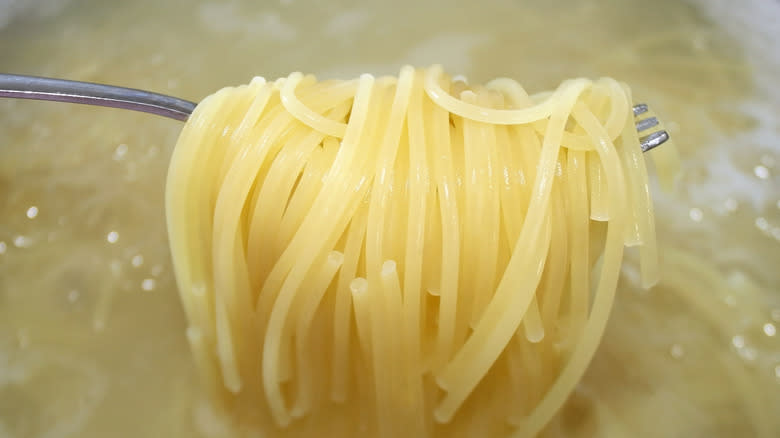
When it comes time to dress your pasta with the sauce, take care to reserve a generous amount of the cooking water it's been simmering in. This magic liquid is filled with lovely starches and loads of flavor that will add a thicker, more velvety texture and added seasoning to the finished dish.
"Adding some of the starchy pasta cooking water is a fantastic technique to help create the perfect texture and bind the sauce to the spaghetti noodles," explains Claudio Daggio. "It also contributes flavor by carrying some of the starchy, wheat-y flavor from the pasta itself. The saltiness from seasoning the pasta water also gets incorporated."
The first time you add cooking water to a pasta dish, it may seem like you've made a big mistake — especially as the thick, rich sauce you've taken so much time and care over thins out. But be patient: You'll soon see the pasta will soak up all of the cooking liquid for an even richer, creamier sauce.
Finish Cooking Your Pasta In The Sauce
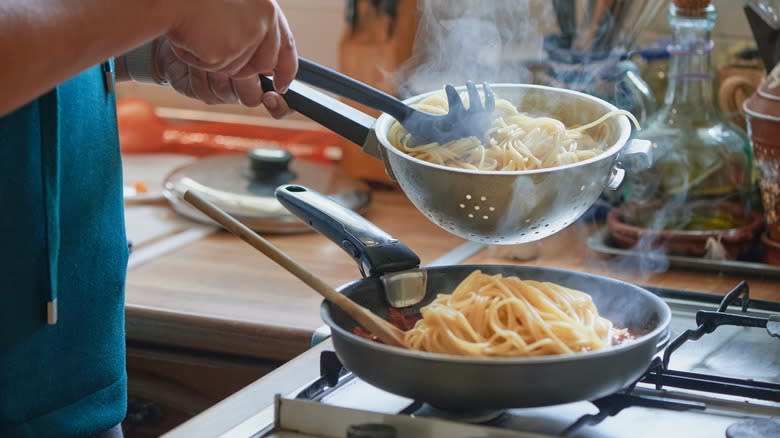
Another way of ensuring the starchy cooking water is integrated perfectly into your pasta sauce is careful mastery of the cooking of your pasta itself. Italians love their spaghetti al dente — to the tooth. But home cooks would do well to try to pull it out of the water a minute before this coveted cuisson, so that the pasta achieves that final minute of cooking directly in the sauce.
This, according to Cucinato, a company producing pasta kits in Canada, is because cooked and drained pasta doesn't absorb the flavor of the sauce the way nearly-cooked pasta does. By adding the pasta to the sauce before it's fully cooked, you give it a chance to soak up the more flavorful liquid in the sauce and become fully integrated with all of those slow-cooked aromas. Use a slotted spoon to transfer the nearly-cooked pasta to the sauce, leaving the starchy cooking water behind. Continue simmering the pasta directly in the sauce until just al dente, thinning the sauce out with starchy cooking water as you go. The finished sauce will be utter perfection.
Don't Forego Jarred Sauces As A Base
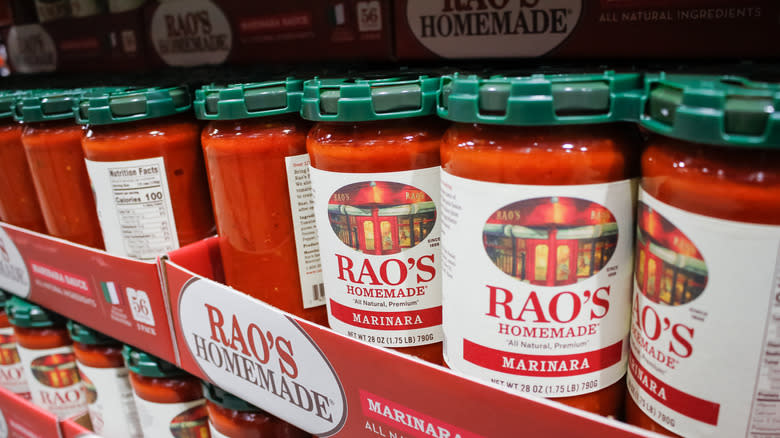
Thanks to our experts, a homemade spaghetti sauce is always within your reach. That said, if you're really strapped for time, don't be afraid of relying on a great jarred sauce — and for this, experts across the country are unanimous. Rao's Homemade Marinara Sauce may be more expensive than some other brands, but it stands out among home cooks and pros like Ina Garten alike for its simple, home-cooked flavor.
"The most delicious sauce ever," raves one reviewer on Amazon of this product. "I am literally so faithful to this sauce. I simply will not made my pasta or spaghetti if I don't have this sauce!" Jarred sauce is usually perfect on its own, but if you want to add a little twist, it's also easy to doctor the sauce with sautéed veggies, herbs, spices, or cheese to add even more flavor.
Read the original article on Mashed

 Yahoo Sports
Yahoo Sports 
